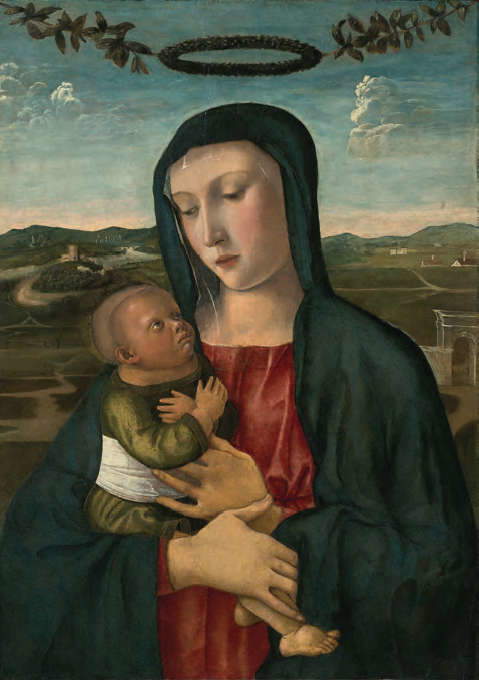Is the small Madonna and Child that is now preserved in the museum set up in the Benedictine abbey on the island of Pag in Croatia by Giovanni Bellini ? That’s the hypothesis, formulated in the October issue of Burlington Magazine, by art historian Beatrice Tanzi , who had this to say about a panel painting dating from the mid-15th century that is in a very precarious state of preservation, but whose surviving fragments nonetheless indicate the presence of a work of high quality. The work may have formerly been in the chapel of St. Nicholas in the monastery church, and was probably inserted into a cusped woodwork, which might suggest that it was originally part of a triptych or polyptych, although, Tanzi points out, fragments of paint in the upper corners of the panel belie this hypothesis.
It is an almost unknown painting to critics, given its location in a secluded and distant place, although Croatian art historians have long discussed it, and the work has also been restored twice, once in the 1970s at the Croatian Institute of Conservation (Hrvatski restauratorski zavod) in Split, and a second in 2011 before the panel was exhibited in an exhibition of Venetian painting in Zagreb. The painting was published in 1982 by Croatian art historian Kruno Prijatelj, who attributed it to the Squarcione school.

According to Beatrice Tanzi, however, we may be in the presence of a work by Bellini: “an important element of the painting that supports an attribution to Bellini,” writes the scholar (the Italian translation is ours), “is the landscape, hilly rather than mountainous, in which vegetation and water are depicted in short brushstrokes, almost in miniature.” Tanzi compares the landscape to those seen in the Crucifixion in the Museo Correr in Venice and the Vir dolorum in the Museo Poldi Pezzoli, Milan, “in which the light of the sky fades gently from blue to white and pink.” An even closer comparison, according to Tanzi, can be made with the landscape of the Fodor Madonna: “The chubby face of the Child in the painting under consideration,” he writes, “recalls the large head and sullen expression of the Child in the Fodor Madonna.” A typology, Tanzi explains, that can be found in other paintings by Bellini, such as the Madonna Davis, the Virgin and Child in the Rijksmuseum in Amsterdam and the one in the Gemäldegalerie in Berlin.
The most significant parallel, however, would be found, according to Tanzi, in the head of the cherub holding Christ on the right in the Dead Christ supported by two cherubs in the Museo Correr in Venice. “The well-preserved child in the Pag panel is painted with extremely short and light strokes, evident even in the folds of the shirt. This sophisticated technique is reminiscent of miniature painting.” The Virgin’s face, though more damaged than that of the Child, can nevertheless be compared to some of Bellini’s works of the 1450s, such as the Nativity of the Virgin (c. 1450; Galleria Sabauda, Turin) or, if one accepts its controversial attribution, the Saint Ursula and Four Saints (1456?; Gallerie dell’Accademia, Venice).
What would a work by Bellini be doing on an island in Croatia? One would owe it to the spread of works by Venetian and Veneto artists on the coasts of Istria and Dalmatia, once subject to the rule of the Serenissima. However, this is a very little-studied area, so much so that the most recent catalog raisonné of Bellini does not mention, Beatrice Tanzi reminds us, any works found in these areas.


However, we have no documents linking any work by Bellini to the Pag convent. In the past, scholar Emil Hilje has suggested that the painting may have been commissioned by a religious man named Benedikt Mišoli�? (1450-1509), who Latinized his surname to De Missolis. “This is confirmed by the fact that this noble family from Pag had strong ties to the monastery,” Tanzi explains, “Katarina, one of Benedict’s aunts, and Milica, one of his sisters, were nuns there.” Benedikt was a Franciscan who graduated in civil and canon law from the University of Padua in 1474, although a “Benedict de Missolis” also served as a canon in Rome, where he had a high reputation, worked as an astrologer and astronomer, risked becoming bishop of Pag in 1483, and even commanded a galley against the Turks. “This diverse set of activities,” Tanzi notes, however, “makes it clear that the family had more than one Benedict, and the one who died in 1509 cannot have commissioned the painting. If, however, one were to accept the dating of the painting proposed here, the Virgin and Child could be linked to Benedict’s father, Giorgio De Missolis,” a nobleman and member of the grand council of Pag, who in 1477 was in charge of settling some issues concerning the sale of salt in Venice, with whom close ties are documented. Could someone like him have acquired the work in Venice? More importantly: are the stylistic matches identified by Beatrice Tanzi enough to attribute the work to Bellini? In short, there is material to discuss.
 |
| Is this Madonna preserved on a Croatian island by Giovanni Bellini? The hypothesis |
Warning: the translation into English of the original Italian article was created using automatic tools. We undertake to review all articles, but we do not guarantee the total absence of inaccuracies in the translation due to the program. You can find the original by clicking on the ITA button. If you find any mistake,please contact us.